Like 2G, 3G and 4G, 5G is not a distinctive sliver, it is a landscape altogether. 5G is essentially about a vision that techno savvy people have in combination, for the uses of currently evolved technologies for the better applicability on most modernize applications. In that sense it is not another cellular system only, or a wireless broadband connectivity system only, but definitely a communication system, which includes them but have far larger perspective.
The sequential term 5G has comes through to address the ‘International Telecommunication Union – Telecom’ (ITU-T) IMT2020 recommendation for the next gen communication system to cater the need of upcoming applications, the improvements over ITU-T advance recommendation for 4G. Mostly these recommendations caters, spectrum efficiency, high data rates, low latency, High subscriber density, power efficiency, flexibility, fast deployment etc.
But industry is not limited to these and have taken a larger perspective, 5G is being seen to enable smart cities, connect vehicles, automate industry, create and analyze Bigdata for better efficiency, use more spectrum, provide ultimate flexibility, adaptable to applications, quickly deployable, cater ‘Internet of Things’ or Internet of Everything’ (IOT/IOE), must survive with massive devices connectivity, apply to high density populations etc. etc.
That has turned 5G to go beyond cellular, and entice a never ending brain storm to talk about it, and discuss on it, about the possible architecture and respective use cases. People have also putting their specific doubts about ‘what to be’ and ‘what not to be’ kind of discussions. Some are taking selective approaches to put the thing on ground and materialize the talks in discussions. Industry analyst ABI Research is forecasting that mobile broadband operators will generate $247 billion in 5G revenues in 2025.
3GPP officially stamped on ‘Non Stand Alone’ (NSA) mode ‘New Radio’ (NR) standardization, Industry has taken some major steps towards 5G by the end of 2017.
Those are like, Verizon is providing home broadband using 5G fixed wireless networks, an effort of replacing fiber, Massive MIMO (Multi Input Multi Output) touches the ground – VERIZON, ERICSSON and Qualcomm Technologies claim that they have completed the first ever FDD MIMO fully compatible customer service. South Korea mobile carrier KT begins installed 5G network in PyeongChang, Olympic in 2018. SK Telecom has plan for 2019 and it created task force of 200 experts to move on 5G (a much appreciated move). AT&T also has put its plan to bring 5G by end of 2018, hand set devices are also gearing up for early devices in market, by 2018.
Although, there would be much pace to adopt 5G in this year- 2018 and coming one, but true 5G will take due time to emerge due to much required deliberation and maturity of technical advances. The real start could be anticipated from 2020 which will be settling to maturity by 2025.
Most important part of talks and discussions is about 5G monetization and plausible use cases, in one of the webinar we attended people voted as below for the possible 5G uses cases, though it’s a small lot of people, but of industry experts, seems to be giving a reflection of current perception for 5G technology in general.
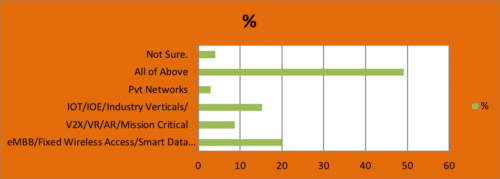
Our interest being with, that almost 50% have voted for all of above option, and we radically proclaim that’s the reality here, relatively shown in vertical bars.
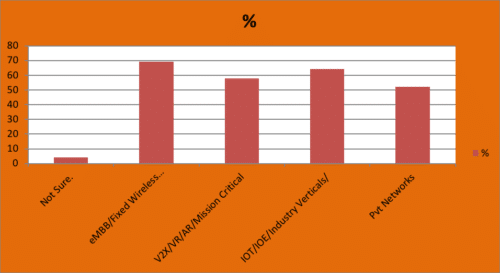
5G is not yet well defined term, and also being hyped to certain extent. This hype is definitely not exorbitant rather this is the much necessity, because it is based on well-grounded though not yet matured technologies. This blurred vision has not yet induced the confidence to ‘Telecom Service Providers’ (TSPs) on part of business decisions, use cases, investment plan etc. but there is a definite eye on the progress of their development and adaptation and industry is taking a selective approach so far.
Broadly, the vision for 5th generation wireless networks (5G) is to enable readiness for applications and use cases for the society of 2020. This would be done by enhancing network throughput by 10x, network scale and traffic capacity by 100x at network efficiency that is 100x better than 4G. Higher spectrum utilization, specifically millimeter bands, is in focus for boosting network throughput by 10x with the goal of supporting 10-20Gbps peak data rates and 100-50Mbps downlink and uplink sustained traffic. A much needed throughput for high density requirements like 1 million devices per km2 area.
Key technology for improving spectrum utilization is to use a large number of antennas at the radio, also called Massive MIMO, for beamforming to allow simultaneous sharing of the spectrum resources in both time and frequency domain among users. 100x improvements in network scale and traffic capacity is needed to support massive Machine Type Communication (mMTC) that will enable connectivity for anything that can be connected.
5G is about the next generation applications, has to cater the emerging perception of everywhere connectivity, i.e. widespread coverage, high data rates and high density spots, and much hyped notion of IOT or IOE, and industry verticals, following need to be addressed in 5G context.
More Spectrum – Below 6GHz and Above 6GHz Specifically Millimeter Waves
- Ultra Low Latency & Ultra High Density Uses
- Uniform data rates, even in fringe area
- Quick service creation and application deployment (<90 min)
- High speed, peak and average data rate
- Green technology, low power consumption
- Unlicensed band /shared bands like CBRS (citizen broadband radio services)
Though 5G has taken the larger horizon, in order to define it as a sequential next gen technology, it has fair continuous transitory requirements. These requirements well could be putted in perspective like….
- Tremendous growth of end devices demanding for the connectivity.
- Ultra-high density requirements.
- Everywhere connectivity kind of paradigm setting.
- Eventual increase in high quality video traffic.
- Spectrum efficiency.
Now coming to next stage applications, which is going to bring almost new set of requirements and define a leap forward from the previous generation.
- Augmented or Virtual Reality (AR/VR) application specific requirements.
- Industry vertical, like for robotics, automation etc.
- Mission critical applications, easily and quickly deployable, adaptable and flexible.
- Dynamic connectivity like Device to Device (D2D), Vehicle to Vehicle (V2V) and Vehicle to Any (V2X).
Many upcoming proposal on 5G impelling to change many facets of wireless stack functionality that were standardized as part of the 4G releases. The industry is divided and rightly questioning undoing functionality that is working well in 4G given the unprecedented success of 4G LTE. Worldwide view of 4G adv pro deployment below shows the widespread adoption of 4G which is also in pace at current time.
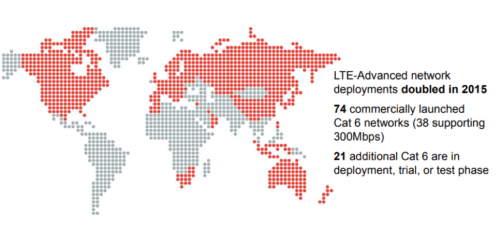
That’s where 4G and 5G both stream will co-exist, as both will progress in a way like 4G dependent 5G and standalone 5G. This will be easing the operators too, who have invested massive on 4G technologies. This approach would be a necessity also to safeguard their investment and futuristic upgradation.
Broadly, in a nutshell, 3GPP and ITU has categorized 5G use cases in three categories.
- IOT/IOE (Internet of Things or Everythings)
- eMBB (enhanced Mobile BroadBand)
- URLLC (Ultra Reliable Low Latency Communication)
IOT/IOE is most evidential use cases for 5G, due to 5G capabilities of connecting millions of devices per km2 and molding the network for various vertical application demands by network slicing.
5G will provide everywhere connectivity with high bandwidth data capability, most opt for application for 5G would be over eMBB, High quality video, video conversation and live streaming are some of the example people opt for in there next devices as of 5G capable.
5G ultra low latency has put a separate attention to provide URLLC applications. 5G radio latency of 1ms and E2E latency of 5-10 ms will provide a remarkable impact of 5G architecture as well.
URLLC has got visualized for low latency machine type communication (MTC) like robotics and VR/AR application, and also in some cases for mission critical applications too, but ultra-low latency has far reaching effect on pure 5G architecture definition.
This ultra-low latency would provide a magical paradigm shift in terms of network availability, consistency and service integrity.
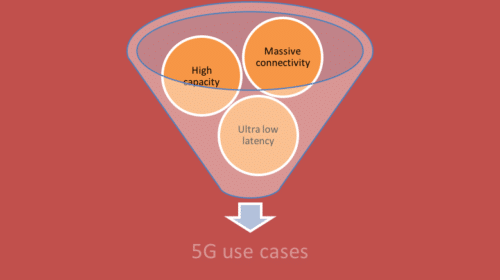
About Architecture-5G
5G Architecture going to be much deliberated conundrum for bringing the much far sighted simplicity, would be guided by the few much strengthening pillars
- Complete separation of control and data plane,
- Distributed control plane & service oriented architecture.
- Large Scale Convergence in data plane.
- Access or Edge network & Non-access or Core Network.
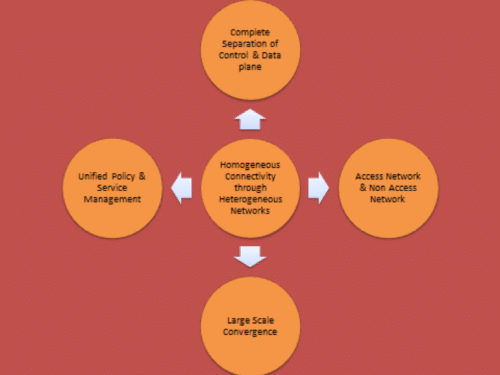
The complete separation of control and data plane give a flexibility in terms of technology amalgamation where control plane can be taken over by much mature technology in terms of coordination, scalability and interoperability. No doubt It is about LTE and its advanced and advanced-pro forms, though some 5G specific improvement could have to bring in like Control plane latency, reliability and coverage for mass connectivity.
Whereas data plane would be about converging of various other technologies for delivering services including LTE as well.
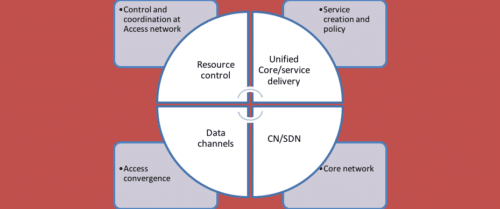
3GPP has already made official its NSA architecture to include 5G NR. In fact it’s a fastest move where 5G will take a required pace, where LTE would be an anchoring technology. NSA is evolution from LTE advance pro technologies like LTE unlicensed (LTE-U), LTE Assisted Access (LAA), and LTE assisted WiFi Access (LWA).
3GPP has already planned its road map for next releases to improve LTE latency (to best suit for 5G control plane) and enhanced bearer connecting in terms of number of bearers, availability and spectrum efficiency.
Recently 3GPP announced completion of ‘Stand Alone’ (SA) mode of standardization too. Industry is focusing on FWA (fixed mobile access) use cases of 5G for immediate deployment plan. SA mode and NSA mode both ways would be taking up through DC (Dual Connectivity) architecture of 5G RAN (Radio Access Network).









